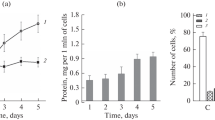Summary
Free radical damage has the potential to significantly affect the behavior of cells in culture. In this study the effects of antioxidants (superoxide dismutase, catalase, and vitamin E) and lowered oxygen tension (1% oxygen) on primary culture of rat mammary epithelial cells were examined. Rat mammary epithelial cells were dissociated in collagenase with or without the addition of antioxidants and low oxygen tension, then cultured for 10 d in rat-tail collagen gel matrix and fed with Dulbecco’s modified Eagle’sF12 medium supplemented with various hormones and growth factors. Growth potential of the mammary cells was enhanced when antioxidants and low oxygen tension were used, alone or in combination, during the cell dissociation period. Using antioxidants and low oxygen tension during the culture period failed to improve growth potential regardless whether cells were dissociated in standard conditions or with antioxidants and low oxygen tension. The use of antioxidants and low oxygen tension during the cell dissociation period also reduced the degree of keratinization of the cells after 10 d of culture. Using antioxidants and low oxygen tension during the cell culture period did not further reduce keratinization if antioxidants and low oxygen tension were used during the dissociation period, but were effective in reducing keratinization if cells were dissociated in standard condition. In this system, antioxidants and low oxygen tension reduced lipid peroxidation during the cell dissociation period. An iron chelator, desferal, can also reduce lipid peroxidation and enhance growth when used during cell dissociation, suggesting the enhanced growth potential by the addition of antioxidants and low oxygen to be due to the reduction of lipid peroxidation.
Similar content being viewed by others
References
Aust, S. D. Lipid peroxidation. CRC handbook of methods for oxygen radical research. Boca Raton, FL: CRC Press; 1985:203–207.
Burton, G. W.; Ingold, K. U.β-Carotene: an unusual type of lipid antioxidant. Science 224:569–573; 1984.
Cerutti, P. A. Active oxygen and promotion. Arachidonic acid metabolism and tumor promotion. Boston: Martinus Nijhoff Publishing; 1985:131–167.
Deeks, S.; Richards, J.; Nandi, S. Maintenance of normal rat mammary epithelial cells by insulin and insulin-like growth factor I. Exp. Cell Res. 174:448–460; 1988.
Fehér, J.; Csomós, G.; Vereckei, A. Control of free radical reactions in biological systems. Free radical reactions in medicine. Berlin: Springer-Verlag; 1985:11–17.
Fehér, J.; Csomós, G.; Vereckei, A. Pathological free radical reactions: general aspects. Free radical reactions in medicine. Berlin: Springer-Verlag; 1985:40–43.
Freeman, B. A.; Crapo, J. D. Biology of disease: free radicals and tissue injury. Lab. Invest. 47:412–426; 1982.
Halliwell, B.; Gutteridge, J. M. C. Lipid peroxidation: a radical chain reaction. Free radicals in biology and medicine. Oxford: Clarendon Press; 1985:139–189.
Halliwell, B.; Gutteridge, J. M. C. Iron and free radical reactions: two aspects of antioxidant protection. Trends in Biochem. Sci. 11:372–375; 1986.
Innes, G. K.; Fuller, B. J.; Hobbs, K. E. F. Lipid peroxidation in hepatocyte cell cultures: modulation by free radical scavengers and iron. In Vitro Cell. Dev. Biol. 24:126–132; 1988.
MacConaill, M. A.; Gurr, E. The histological properties of Rhodanile blue. Ir. J. Med. Sci. June:243–250; 1964.
Marnett, L. J. Peroxyl free radicals: potential mediators of tumor initiation and promotion. Carcinogenesis 8:1365–1373; 1987.
Masotti, L.; Casali, E.; Galeotti, T. Lipid peroxidation in tumour cells. Free Rad. Biol. Med. 4:377–386; 1988.
McGrath, M.; Palmer, S.; Nandi, S. Differential response of normal rat mammary epithelial cells to mammogenic hormones and EGF. J. Cell Physiol. 125:182–191; 1985.
Oberley, L. W.; Spitz, D. R. Nitroblue tetrazolium. CRC handbook of methods for oxygen radical research. Boca Raton, FL: CRC Press; 1985:217–220.
Richter, A.; Sanford, K. K.; Evans, V. J. Influence of oxygen and culture media on plating efficiency of some mammalian tissue cells. JNCI 49:1705–1712; 1972.
Schaefer, F. V.; Custer, R. P.; Sorof, S. Induction of abnormal development in cultured mammary glands by cyclic adenine nucleotide and prostaglandins. Nature 286:807–810; 1980.
Schaefer, F. V.; Custer, R. P.; Sorof, S. Squamous metaplasia in human breast culture: induction by cyclic adenosine nucleotide and prostaglandins, and influence of menstrual cycle. Cancer Res. 43:279–286; 1983.
Author information
Authors and Affiliations
Additional information
This study is supported by grants CA05388 and GM11903 to Y. K. H. from the Public Health Service, U.S. Department of Health and Human Services, Washington, DC.
Rights and permissions
About this article
Cite this article
Lin, TP., Hom, Y.K., Richards, J. et al. Effects of antioxidants and reduced oxygen tension on rat mammary epithelial cells in culture. In Vitro Cell Dev Biol - Animal 27, 191–196 (1991). https://doi.org/10.1007/BF02630915
Received:
Accepted:
Issue Date:
DOI: https://doi.org/10.1007/BF02630915




